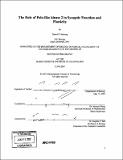The role of Polo-like kinase 2 in synaptic function and plasticity
Author(s)
Seeburg, Daniel P. (Daniel Philip)
DownloadFull printable version (6.744Mb)
Alternative title
Role of Plk2 in synaptic function and plasticity
Other Contributors
Massachusetts Institute of Technology. Dept. of Biology.
Advisor
Morgan Sheng.
Terms of use
Metadata
Show full item recordAbstract
Homeostatic forms of plasticity keep the spiking output of neurons within an optimal range in the face of changing activity levels of the surrounding network, but little is known about the underlying molecular mechanisms, particularly during heightened activity. We report in Chapter 2 that in hippocampal neurons experiencing elevated activity, the activity-inducible protein kinase, Polo-like kinase 2 (Plk2), was required for synaptic scaling in dissociated culture and for reducing membrane excitability in slice culture-two principal compensatory mechanisms underlying homeostatic plasticity. Inhibition of Plk2 activity in slice culture during elevated activity resulted in increased dendritic spine size and density as well as a "run-up" in synaptic strength that prevented subsequent LTP. Thus, the homeostatic functions of Plk2 allow synapses to remain within a modifiable range during prolonged heightened network activity. In Chapter 3, we show that the homeostatic prevention of run-up during elevated activity also depended on CDK5, which acted as a "priming" kinase for the phospho-dependent binding of PIk2 to its substrate SPAR, a postsynaptic RapGAP. (cont.) Overexpression of SPAR strengthened synapses, whereas RNAi knockdown of SPAR weakened synapses and disrupted homeostasis. Thus CDK5-dependent recruitment of Plk2 to SPAR, followed by Plk2-mediated degradation of SPAR, constitutes a likely molecular mechanism for Plk2-dependent homeostatic plasticity in neurons.
Description
Thesis (Ph. D.)--Massachusetts Institute of Technology, Dept. of Biology, 2007. Includes bibliographical references.
Date issued
2007Department
Massachusetts Institute of Technology. Department of BiologyPublisher
Massachusetts Institute of Technology
Keywords
Biology.